L-Band Passive Microwave Data from SMOS for River Gauging Observations in Tropical Climates
Abstract
1. Introduction
2. Methods
2.1. GFDS Single Sensor Method
2.2. SMOS Data Processing
2.3. SMOS Time Series Filtering
- mean filter: moving average over given time window,
- median filter: moving median over given time window,
- peak envelope filter: smoothly varying estimate of highs and lows of a signal averaged in a given time window [55],
- spline smoothening: cubic smoothing curve fitted to the data applying a parameter that controls the degree of fit [55],
- local regression: locally weighted linear regression where smoothed value is determined by neighboring data points defined within a given span [55].
3. Results
3.1. Performance of SMOS-Based River Gauging
3.2. Validation of SMOS Gauging Results
4. Discussions
5. Conclusions
Author Contributions
Funding
Acknowledgments
Conflicts of Interest
References
- Alsdorf, D.E.; Rodríguez, E.; Lettenmaier, D.P. Measuring surface water from space. Rev. Geophys. 2007, 45, RG2002. [Google Scholar] [CrossRef]
- Hollyday, E.F. Improving estimates of streamflow characteristics by using Landsat-1 imagery. J. Res. US Geol. Surv. 1976, 4, 517–531. [Google Scholar]
- Rango, A.; Salomonson, V.V. Regional food mapping from space. Water Resour. Res. 1974, 10, 473–484. [Google Scholar] [CrossRef]
- Blasco, F.; Bellan, M.F.; Chaudhury, M.U. Estimating the extent of floods in Bangladesh using SPOT data. Remote Sens. Environ. 1992, 39, 167–178. [Google Scholar] [CrossRef]
- Hansen, M.C.; DeFries, R.S.; Townshend, J.R.G.; Sohlberg, R.; Dimiceli, C.; Carroll, M. Towards an operational MODIS continuous field of percent tree cover algorithm: Examples using AVHRR and MODIS data. Remote Sens. Environ. 2002, 83, 303–319. [Google Scholar] [CrossRef]
- Kugler, Z. The Use of GIS and Remote Sensing in Flood Disaster Management in Mozambique. In II. PhD CivilExpo Symposium Proceedings: BUTE Dept. of Highway and Railway Engineering; Barna, Z., Fenyős, D., Eds.; BME: Budapest, Hungary, 2004; pp. 84–88. ISBN 963-421-600-5. [Google Scholar]
- Brakenridge, G.R.; Nghiem, S.V.; Anderson, E.; Chien, S. Space-based measurement of river runoff. EOS Trans. Am. Geophys. Union 2005, 86, 185–188. [Google Scholar] [CrossRef]
- Nigro, J.; Slayback, D.; Policelli, F.; Brakenridge, G.R. NASA/DFO MODIS Near Real-Time (NRT) Global Flood Mapping Product-Evaluation of Flood and Permanent Water Detection; Technical Report; NASA GSFC: Greenbelt, MD, USA, 2014.
- O’Grady, D.; Leblanc, M.; Gillieson, D. Use of ENVISAT ASAR Global Monitoring Mode to complement optical data in the mapping of rapid broad-scale flooding in Pakistan. Hydrol. Earth Syst. Sci. 2011, 15, 3475–3494. [Google Scholar] [CrossRef]
- Horritt, M.S.; Mason, D.C.; Luckman, A.J. Flood boundary delineation from Synthetic Aperture Radar imagery using a statistical active contour model. Int. J. Remote Sens. 2001, 22, 2489–2507. [Google Scholar] [CrossRef]
- Henry, J.B.; Chastanet, P.; Fellah, K.; Desnos, Y.L. Envisat multi-polarized ASAR data for flood mapping. Int. J. Remote Sens. 2006, 27, 1921–1929. [Google Scholar] [CrossRef]
- Cossu, R.; Schoepfer, E.; Bally, P.; Fusco, L. Near real-time SAR-based processing to support flood monitoring. J. Real-Time Image Process. 2009, 4, 205–218. [Google Scholar] [CrossRef]
- Martinis, S.; Twele, A.; Voigt, S. Towards operational near real-time flood detection using a split-based automatic thresh-olding procedure on high resolution TerraSAR-X data. Nat. Hazards Earth Syst. Sci. 2009, 9, 303–314. [Google Scholar] [CrossRef]
- Pierdicca, N.; Pulvirenti, L.; Chini, M.; Guerriero, L.; Candela, L. Observing floods from space: Experience gained from COSMO-SkyMed observations. Acta Astronaut. 2013, 84, 122–133. [Google Scholar] [CrossRef]
- Alsdorf, D.E.; Smith, L.C.; Melack, J.M. Amazon floodplain water level changes measured with interferometric SIR-C radar. IEEE Trans. Geosci. Remote Sens. 2001, 39, 423–431. [Google Scholar] [CrossRef]
- Birkett, C.M.; Mertes, L.; Dunne, T.; Costa, M.; Jasinski, J. Altimetric remote sensing of the Amazon: Application of satellite radar altimetry. J. Geophys. Res. Atmos. 2002, 107, 8059. [Google Scholar] [CrossRef]
- Kouraev, A.; Zakharova, E.A.; Samain, O.; Mognard-Campbell, N.; Cazenave, A. Ob’river discharge from Topex/Poseidon satellite altimetry. Remote Sens. Environ. 2004, 93, 238–245. [Google Scholar] [CrossRef]
- Seyler, F.; Calmant, S.; da Silva, J.S.; Moreira, D.; Mercier, F.; Shum, C.K. From TOPEX/Poseidon to Jason-2/OSTM in the Amazon basin. Adv. Space Res. 2013, 51, 1542–1550. [Google Scholar] [CrossRef]
- Crétaux, J.-F.; Jelinski, W.; Calmant, S.; Kouraev, A.; Vuglinski, V.; Bergé-Nguyen, M.; Gennero, M.-C.; Nino, F.; Abarca Del Rio, R.; Cazenave, A.; et al. SOLS: A Lake database to monitor in Near Real Time water level and storage variations from remote sensing data. J. Adv. Space Res. 2011, 5. [Google Scholar] [CrossRef]
- Campos, I.; Mercier, F.; Maheu, C.; Cochonneau, G.; Kosuth, P.; Blitzkow, D.; Cazenave, A. Temporal variations of river basin waters from Topex/Poseidon satellite altimetry. Application to the Amazon basin. C. R. l’Acad. Sci. Ser. IIA Earth Planet. Sci. 2001, 333, 633–643. [Google Scholar] [CrossRef]
- Birkett, C.; Reynolds, C.; Beckley, B.; Doorn, B. From Research to Operations: The USDA Global Reservoir and Lake Monitor. In Coastal Altimetry; Vignudelli, S., Kostianoy, A., Cipollini, P., Benveniste, J., Eds.; Springer: Berlin/Heidelberg, Germany, 2011; pp. 19–50. [Google Scholar] [CrossRef]
- Stippel, S.J.; Hamilton, S.K.; Melack, J.M.; Choudhury, B.J. Determination of inundation area in the Amazon River floodplain using SMMR 37 GHz polarization difference. Remote Sens. Environ. 1994, 48, 70–76. [Google Scholar] [CrossRef]
- Harris, A.; Rahman, S.; Faisal, H.; Lance, Y.; Amvrossios, B.; Greg, E. Satellite-based Flood Modeling Using TRMM-based Rainfall Products. Sensors 2007, 7, 3416. [Google Scholar] [CrossRef] [PubMed]
- Ferrazzoli, P.; Rahmoune, R.; Grings, F.; Douna, V.; Parmuchi, G.; Salvia, M.; Karszenbaum, H. AMSR-E observations of rain and flood events over vegetated areas of LA Plata basin. In Proceedings of the 2010 11th Specialist Meeting on Microwave Radiometry and Remote Sensing of the Environment, New Brunswick, NJ, USA, 1–4 March 2010; pp. 63–66. [Google Scholar] [CrossRef]
- Lacava, T.; Cuomo, V.; Di Leo, E.V.; Pergola, N.; Romano, F.; Tramutoli, V. Improving soil wetness variations monitoring from passive microwave satellite data: The case of April 2000 Hungary flood. Remote Sens. Environ. 2005, 96, 135–148. [Google Scholar] [CrossRef]
- Temimi, M.; Leconte, R.; Brissette, F.; Chaouch, N. Flood and soil wetness monitoring over the Mackenzie River Basin using AMSR-E 37GHz brightness temperature. J. Hydrol. 2007, 333, 317–328. [Google Scholar] [CrossRef]
- Brakenridge, G.R.; Nghiem, S.V.; Anderson, E.; Mic, R. Orbital microwave measurement of river discharge and ice status. Water Resour. Res. 2007, 43. [Google Scholar] [CrossRef]
- Kugler, Z.; De Groeve, T.; Brakenridge, G.R.; Anderson, E. Towards Near-real Time Global Flood Detection System. Int. Arch. Photogramm. Remote Sens. 2007, XXXVI Pt 7, 1–8. [Google Scholar]
- Brakenridge, G.R.; Cohen, S.; Kettner, A.J.; De Groeve, T.; Nghiem, S.V.; Syvitski, J.P.M.; Fekete, B.M. Calibration of orbital microwave measurements of river discharge using a global hydrology model. J. Hydrol. 2012, 475, 123–136. [Google Scholar] [CrossRef]
- Kugler, Z. Remote sensing for natural hazard mitigation and climate change impact assessment. Időjárás/Q. J. Hung. Meteorol. Serv. 2012, 116, 21–39. [Google Scholar]
- Amarnath, G.; Ameer, M.; Aggarwal, P.; Smakhtin, V. Detecting spatio-temporal changes in the extent of seasonal and annual flooding in South Asia using multi-resolution satellite data. Proc. SPIE Int. Soc. Opt. Eng. 2012, 8538, 853818. [Google Scholar]
- Zhang, Y.; Hong, Y.; Wang, X.; Gourley, J.J.; Gao, J.; Vergara, H.J.; Yong, B. Assimilation of Passive Microwave Streamflow Signals for Improving Flood Forecasting: A First Study in Cubango River Basin, Africa. IEEE J. Sel. Top. Appl. Earth Obs. Remote Sens. 2013, 6, 2375–2390. [Google Scholar] [CrossRef]
- D’Andrimont, R.; Defourny, P. Monitoring African water bodies from twice-daily MODIS observation. Gisci. Remote Sens. 2017, 55, 130–153. [Google Scholar]
- Zaji, A.; Bonakdari, H.; Gharabaghi, B. Remote Sensing Satellite Data Preparation for Simulating and Forecasting River Discharge. IEEE Trans. Geosci. Remote Sens. 2018, 56, 3432–3441. [Google Scholar] [CrossRef]
- Shi, Z.; Huang, C. Evaluation of Discharge Estimation Using Global Flood Detection System. In Proceedings of the 2018 7th International Conference on Agro-geoinformatics (Agro-geoinformatics), Hangzhou, China, 6–9 August 2018; pp. 1–4. [Google Scholar] [CrossRef]
- Revilla-Romero, B.; Thielen, J.; Salamon, P.; De Groeve, T.; Brakenridge, G.R. Evaluation of the satellite-based Global Flood Detection System for measuring river discharge: Influence of local factors. Hydrol. Earth Syst. Sci. 2014, 18, 4467–4484. [Google Scholar] [CrossRef]
- Hirpa, F.A.; Hopson, T.M.; De Groeve, T.; Brakenridge, G.R.; Gebremichael, M.; Restrepo, P.J. Upstream satellite remote sensing for river discharge forecasting: Application to major rivers in South Asia. Remote Sens. Environ. 2013, 131, 140–151. [Google Scholar] [CrossRef]
- Syvitski, J.P.M.; Brakenridge, G.R. Causation and avoidance of catastrophic flooding along the Indus River, Pakistan. GSA Today 2013, 23, 4–10. [Google Scholar] [CrossRef]
- Brakenridge, G.R.; Syvitski, J.P.M.; Niebuhr, E.; Overeem, I.; Higgins, S.A.; Kettner, A.J.; Prades, L. Design with Nature: Causation and avoidance of catastrophic floods in Myanmar. Earth-Sci. Rev. 2016, 165, 81–109. [Google Scholar] [CrossRef]
- Brakenridge, G.R. Flood risk mapping from orbital remote sensing. In Global Flood Hazard: Applications in Modeling, Mapping and Forecasting; AGU Monograph Series; Schumann, G.J., Bates, P.D., Apel, H., Aronica, G.T., Eds.; John Wiley & Sons: Hoboken, NJ, USA, 2018; pp. 43–54. [Google Scholar]
- De Groeve, T.; Brakenridge, G.R.; Paris, S. Global Flood Detection System Data Product Specifications. JRC Technical Report. 2015. Available online: http://www.gdacs.org/flooddetection/Download/Technical_Note_GFDS_Data_Products_v1.pdf (accessed on 6 February 2019).
- Revilla-Romero, B.; Wanders, N.; Burek, P.; Salamon, P.; de Roo, A. Integrating remotely sensed surface water extent into continental scale hydrology. J. Hydrol. 2016, 543, 659–670. [Google Scholar] [CrossRef]
- Van Dijk, A.I.J.M.; Brakenridge, G.R.; Kettner, A.J.; Beck, J.E.; De Groeve, T. River gauging at global scale using optical and passive microwave remote sensing. Water Resour. Res. 2016, 52, 6404–6418. [Google Scholar] [CrossRef]
- Mertes, L.A.K.; Daniel, D.L.; Melack, J.M.; Nelson, B.; Martinelli, L.A.; Forsberg, B.R. Spatial patterns of hydrology, geomorphology, and vegetation on the floodplain of the Amazon river in Brazil from a remote sensing perspective. Geomorphology 1995, 13, 215–232. [Google Scholar] [CrossRef]
- Munier, S.; Carrer, D.; Planque, C.; Camacho, F.; Albergel, C.; Calvet, J. Satellite Leaf Area Index: Global Scale Analysis of the Tendencies Per Vegetation Type over the Last 17 Years. Remote Sens. 2018, 10, 424. [Google Scholar] [CrossRef]
- Kerr, Y.H.; Waldteufel, P.; Wigneron, J.; Delwart, S.; Cabot, F.; Boutin, J.; Escorihuela, M.; Font, J.; Reul, N.; Gruhier, C.; et al. The SMOS Mission: New Tool for Monitoring Key Elements of the Global Water Cycle. Proc. IEEE 2010, 98, 666–687. [Google Scholar] [CrossRef]
- Van der Schalie, R.; Kerr, Y.; Wigneron, J.-P.; Rodríguez-Fernández, N.J.; Al-Yaari, A.; de Jeu, R. Global SMOS Soil Moisture Retrievals from The Land Parameter Retrieval Mode. Int. J. Appl. Earth Obs. Geoinf. 2016, 45, 125–134. [Google Scholar] [CrossRef]
- Boutin, J.; Martin, N.; Kolodziejczyk, N.; Reverdin, G. Interannual anomalies of SMOS sea surface salinity. Remote Sens. Environ. 2016, 180, 128–136. [Google Scholar] [CrossRef]
- Vittucci, C.; Guerriero, L.; Ferrazzoli, P.; Rahmoune, R.; Barraza, V.; Grings, F. River Water Level Prediction Using Passive Microwave Signatures—A Case Study: The Bermejo Basin. IEEE J. Sel. Top. Appl. Earth Obs. Remote Sens. 2014, 7, 3903–3914. [Google Scholar] [CrossRef]
- Parrens, M.; Al Bitar, A.; Frappart, F.; Papa, F.; Calmant, S.; Crétaux, J.-F.; Wigneron, J.-P.; Kerr, Y. Mapping Dynamic Water Fraction under the Tropical Rain Forests of the Amazonian Basin from SMOS Brightness Temperatures. Water 2017, 9, 350. [Google Scholar] [CrossRef]
- Jacquette, E.; Al Bitar, A.; Mialon, A.; Kerr, Y.; Quesney, A.; Cabot, F.; Richaume, P. SMOS CATDS level 3 global products over land. Proc. SPIE 2010, 7824. [Google Scholar] [CrossRef]
- Al Bitar, A.; Mialon, A.; Kerr, Y.H.; Cabot, F.; Richaume, P.; Jacquette, E.; Quesney, A.; Mahmoodi, A.; Tarot, S.; Parrens, M.; et al. The global SMOS Level 3 daily soil moisture and brightness temperature maps. Earth Syst. Sci. Data 2017, 9, 293–315. [Google Scholar] [CrossRef]
- Quesney, A.; Berthon, L. Function to convert lat/lon to row/col on the EASE grid (EASE 2.0). Available online: http://www.cesbio.ups-tlse.fr/SMOS_blog/?page_id=749 (accessed on 6 February 2019).
- De Groeve, T.; Brakenridge, R.G.; Paris, S. Global Flood Detection System: Data Product Specifications, Technical Report, European Commission. Joint Research Centre, 2015, JRC97421. Available online: https://ec.europa.eu/jrc (accessed on 6 February 2019).
- Kendall, M.G.; Stuart, A.; Ord, J.K. The Advanced Theory of Statistics, Vol. 3: Design and Analysis, and Time-Series, 4th ed.; Macmillan: London, UK, 1983. [Google Scholar]
- Nghiem, S.V.; Zuffada, C.; Shah, R.; Chew, C.; Lowe, S.T.; Mannucci, A.J.; Cardellach, E.; Brakenridge, G.R.; Geller, G.; Rosenqvist, A. Wetland Dynamics Monitoring with Global Navigation Satellite System Reflectometry. Earth Space Sci. 2017, 4, 16–39. [Google Scholar] [CrossRef]
- Nash, J.E.; Sutcliffe, J.V. River flow forecasting through conceptual models part I—A discussion of principles. J. Hydrol. 1970, 10, 282–290. [Google Scholar] [CrossRef]
- Nghiem, S.V.; Wardlow, D.B.; Allured, D.; Svoboda, M.D.; LeComte, D.; Rosencrans, M.; Chan, K.S.; Neumann, G. Microwave Remote Sensing of Soil Moisture—Science and Applications. In Remote Sensing of Drought—Innovative Monitoring Approaches; Drought and Water Crises Book Series; CRC Press, Taylor and Francis: Boca Raton, FL, USA, 2012; Chapter 9, Part III; pp. 197–226. ISBN 978-1-4398-3557-9. [Google Scholar]
- Piedade, M.T.; Junk, W.; Agra D’Ângelo, S.; Wittmann, F.; Schöngart, J.; Mara Do Nascimento Barbosa, K.; Lopes, A. Aquatic herbaceous plants of the Amazon floodplains: State of the art and research needed. Acta Limnol. Bras. 2010, 22, 165–178. [Google Scholar] [CrossRef]
- Juhász, A. Managing temporal data in military historical GIS. In Proceedings of the 31th Symposium of the European Association of Remote Sensing Laboratories, Prague, Czech Republic, 30 May–2 June 2011; pp. 43–53. [Google Scholar]
- De Groeve, T. Flood monitoring and mapping using passive microwave remote sensing in Namibia. Geomat. Nat. Hazards Risk 2010, 1, 19–35. [Google Scholar] [CrossRef]

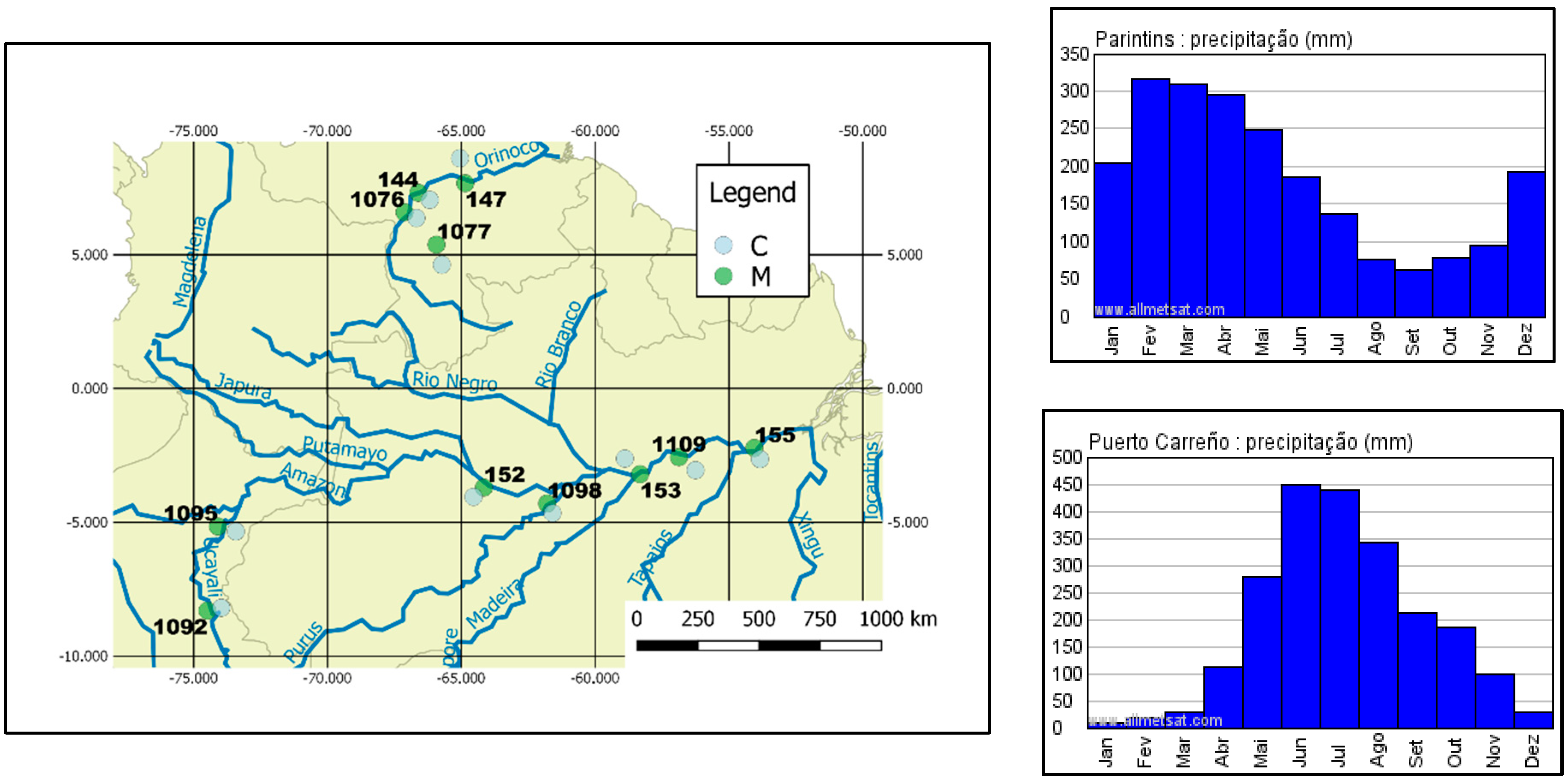
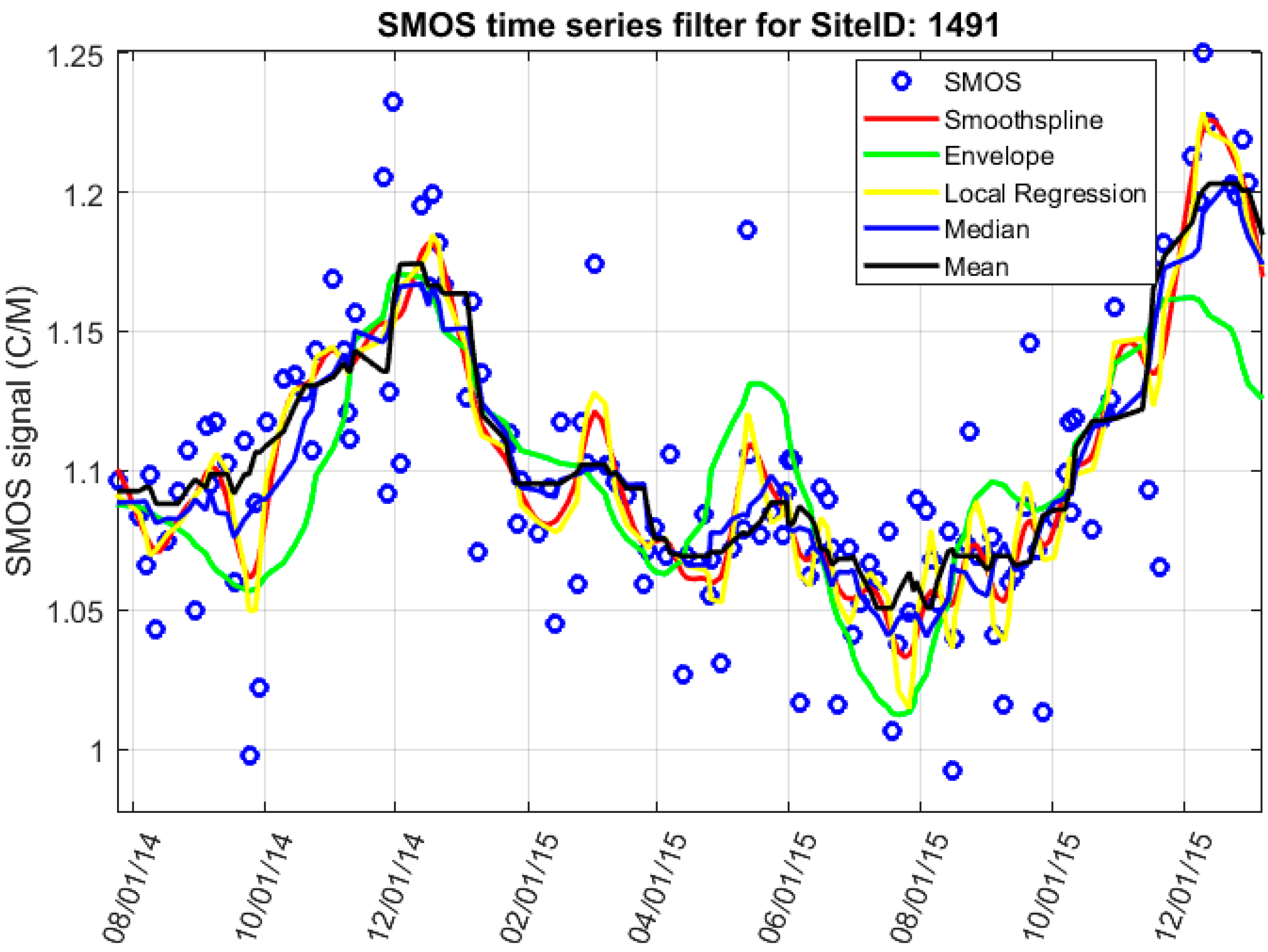
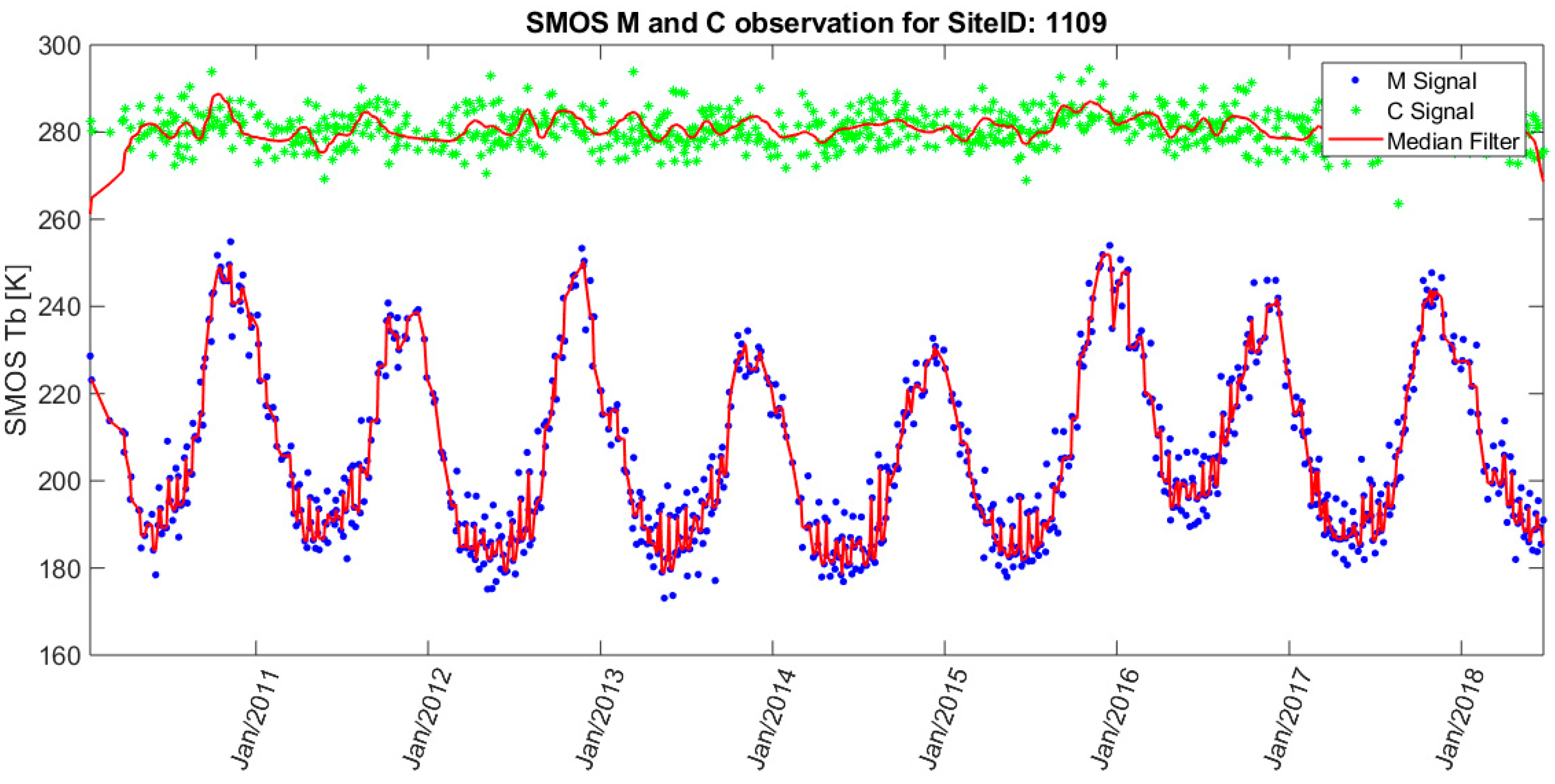
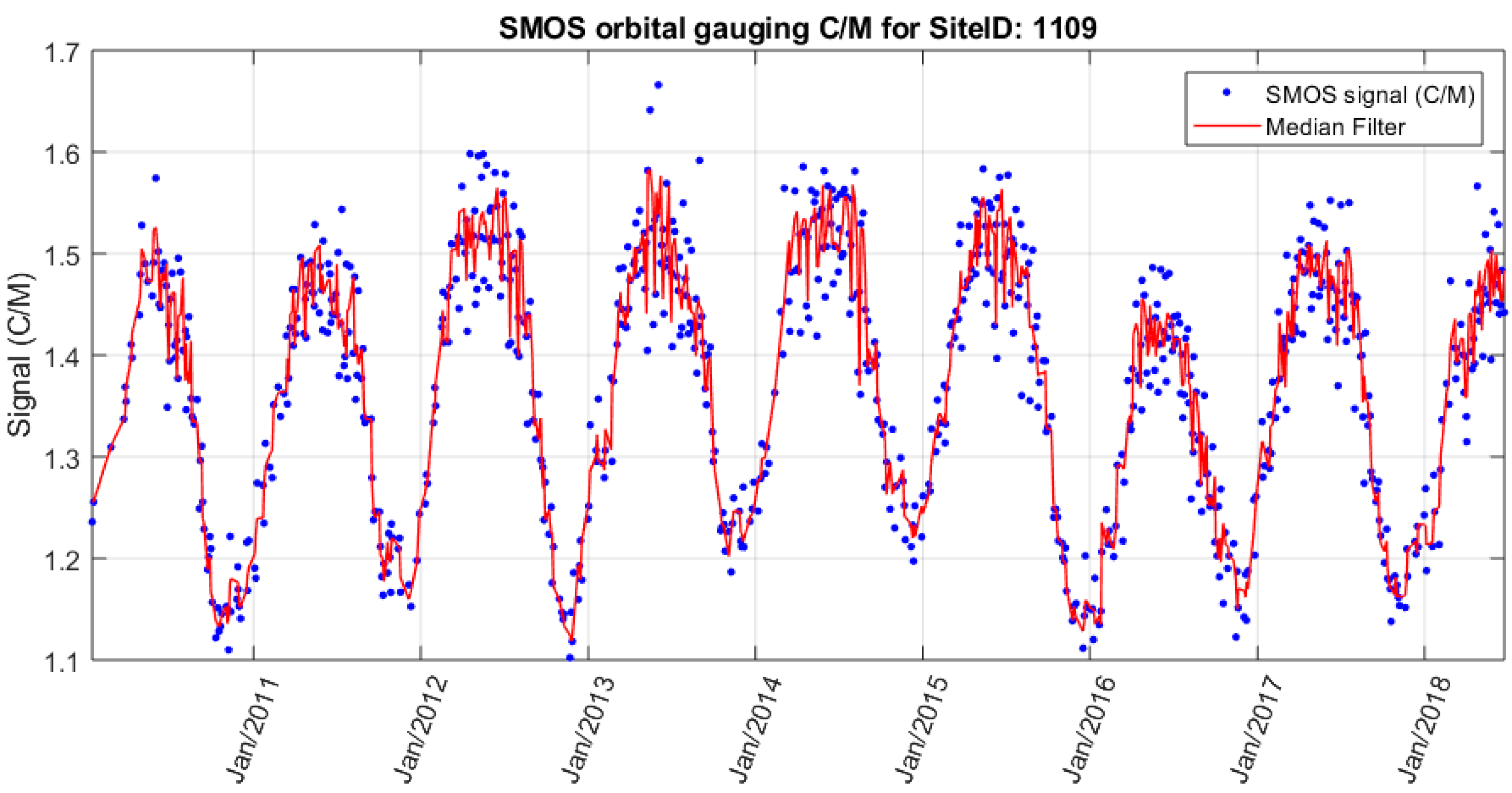

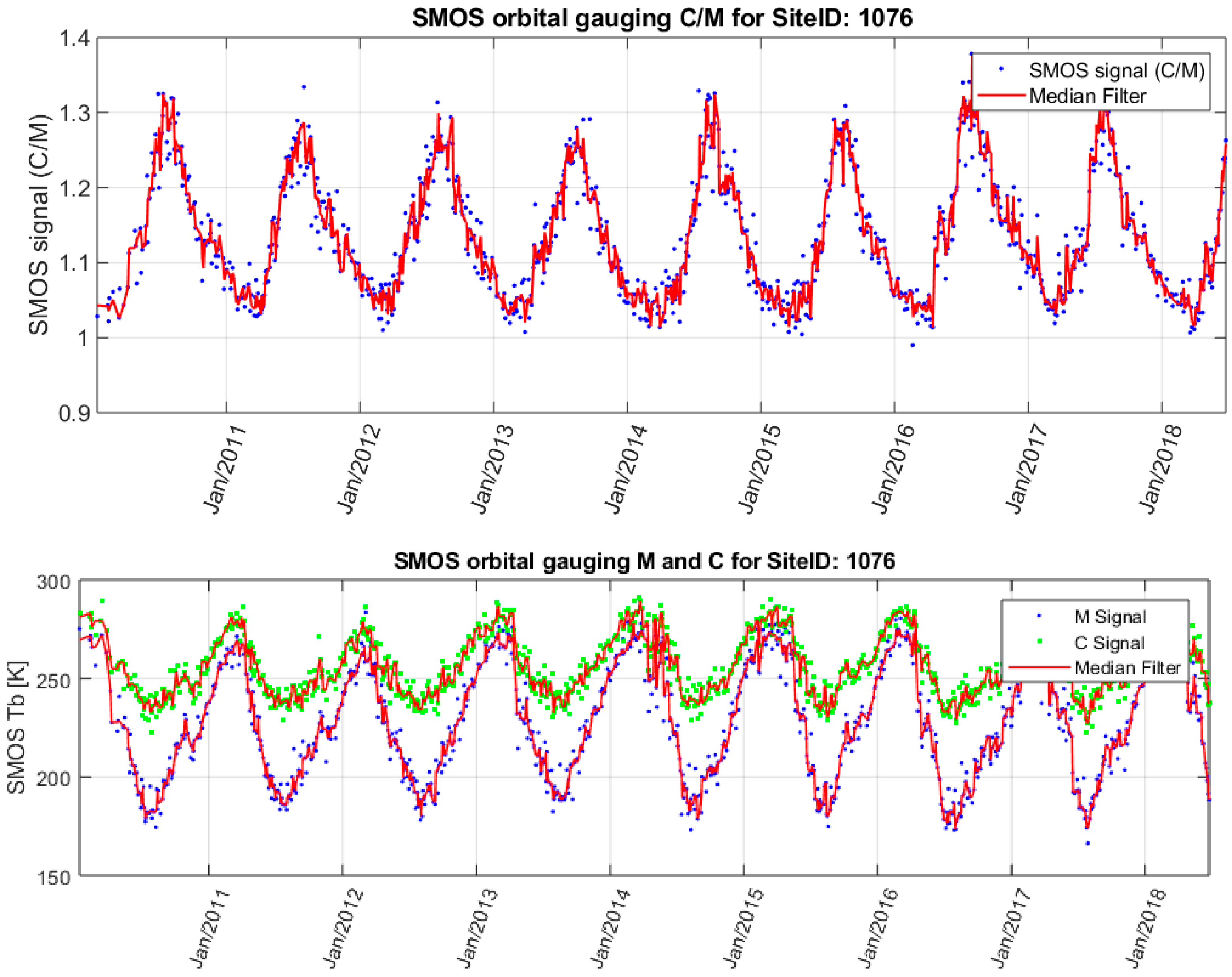
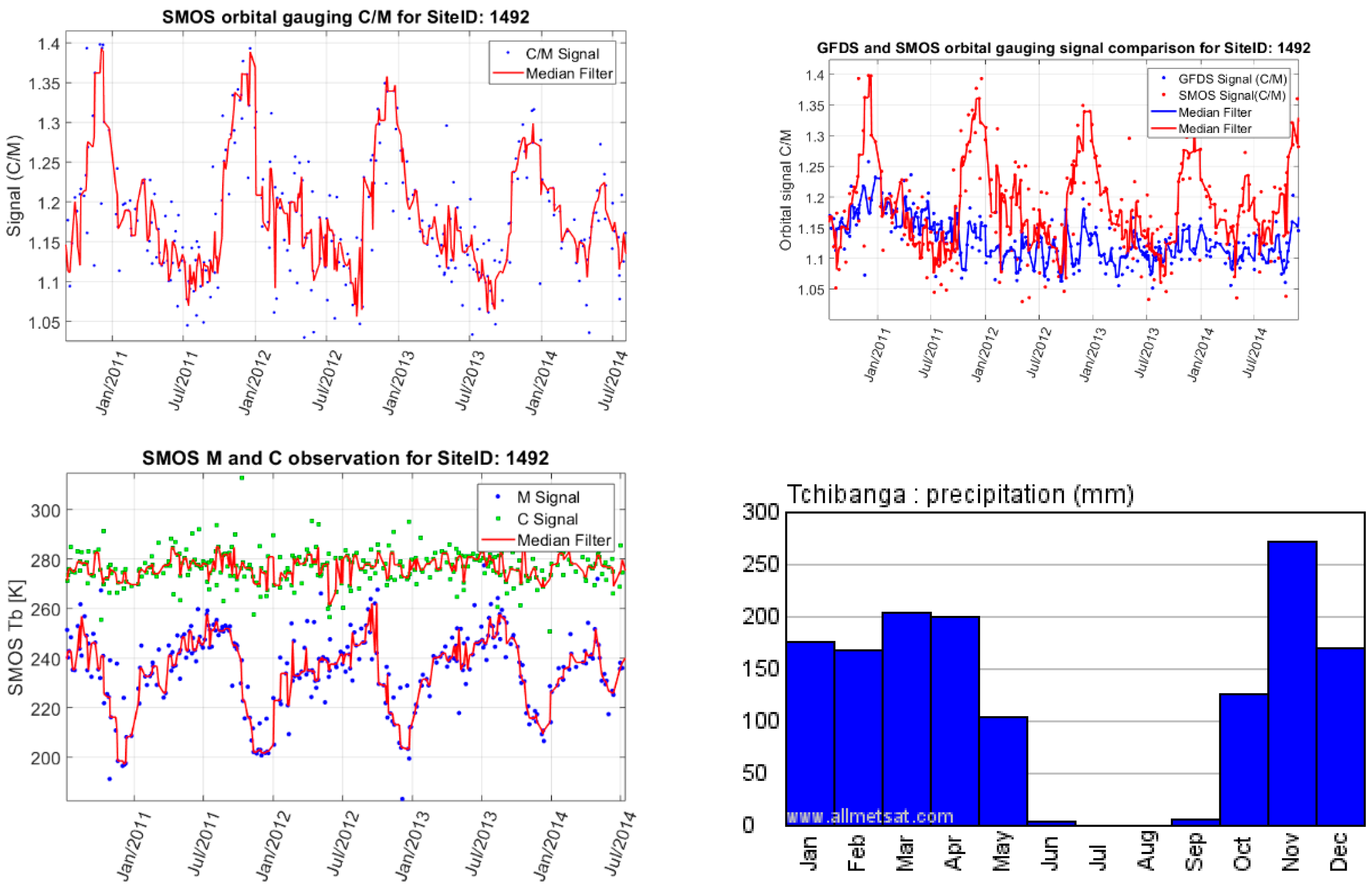

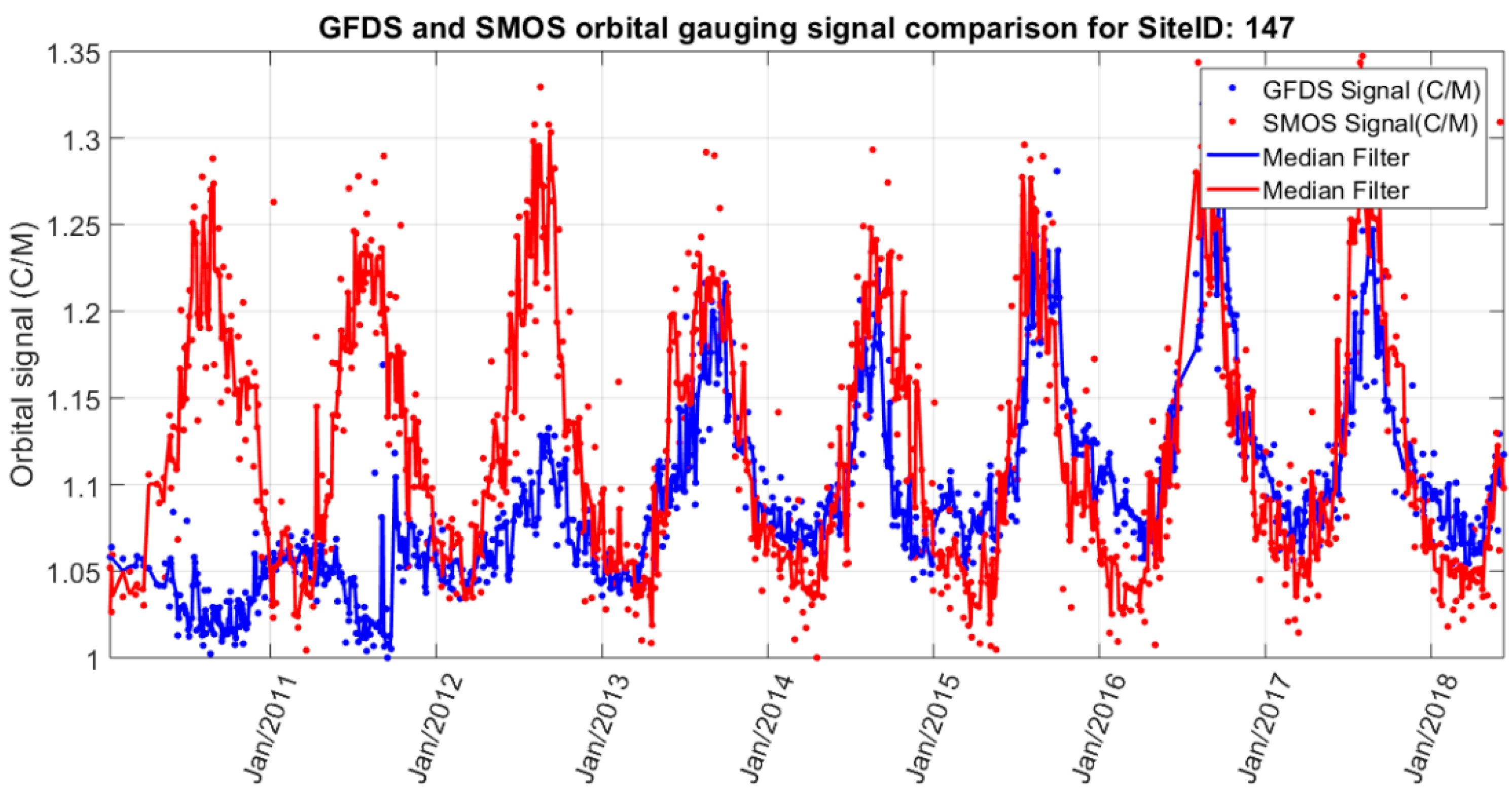
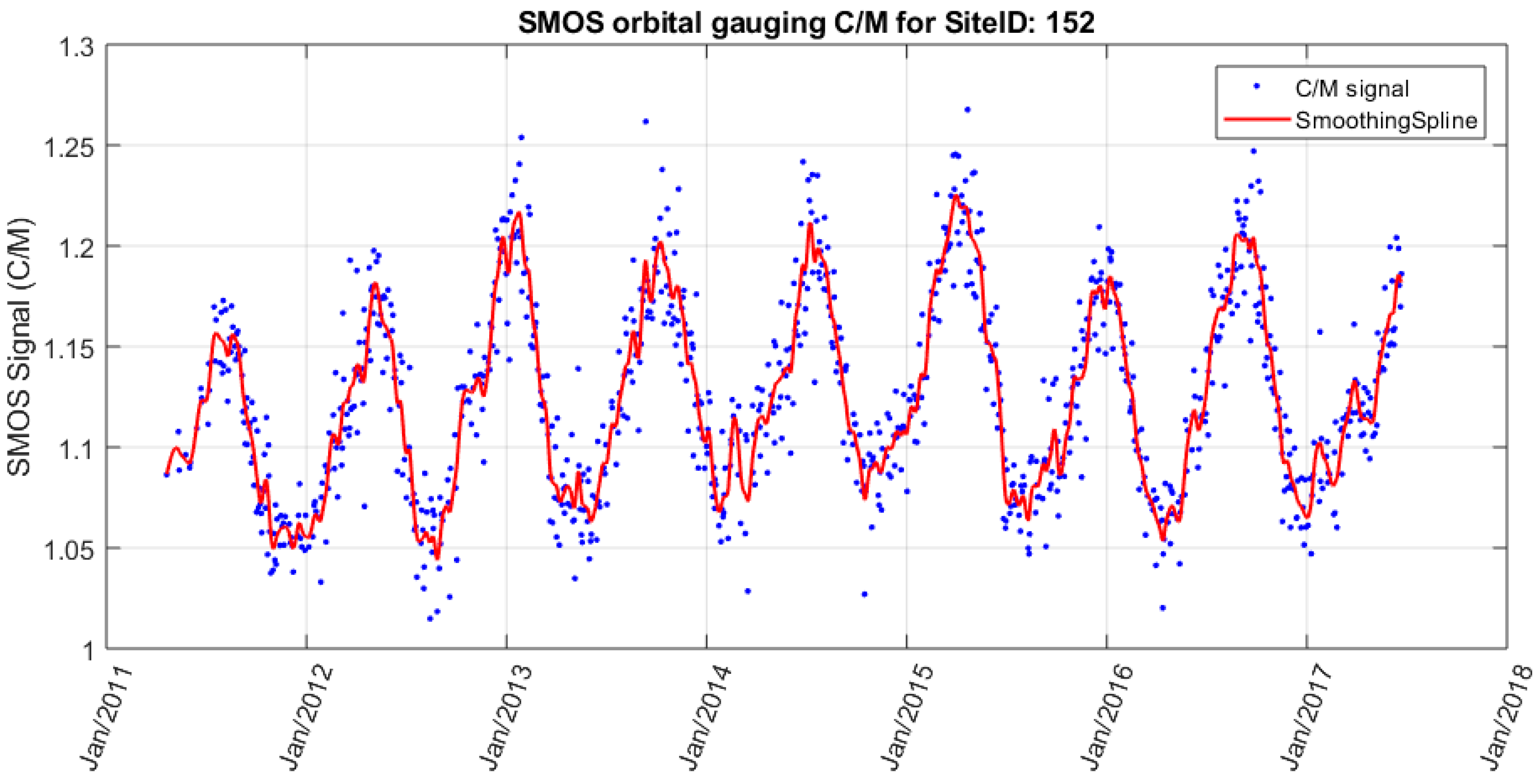
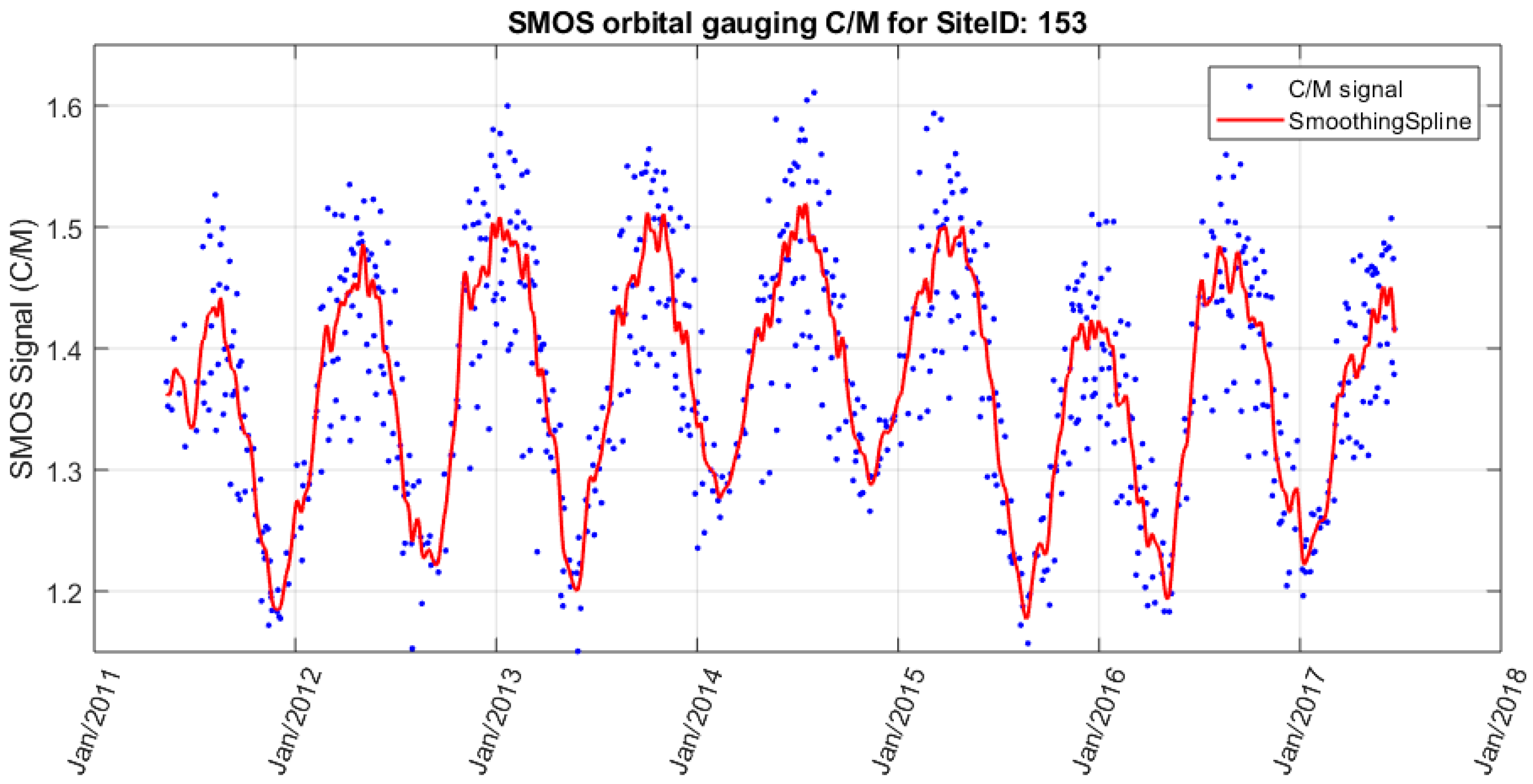
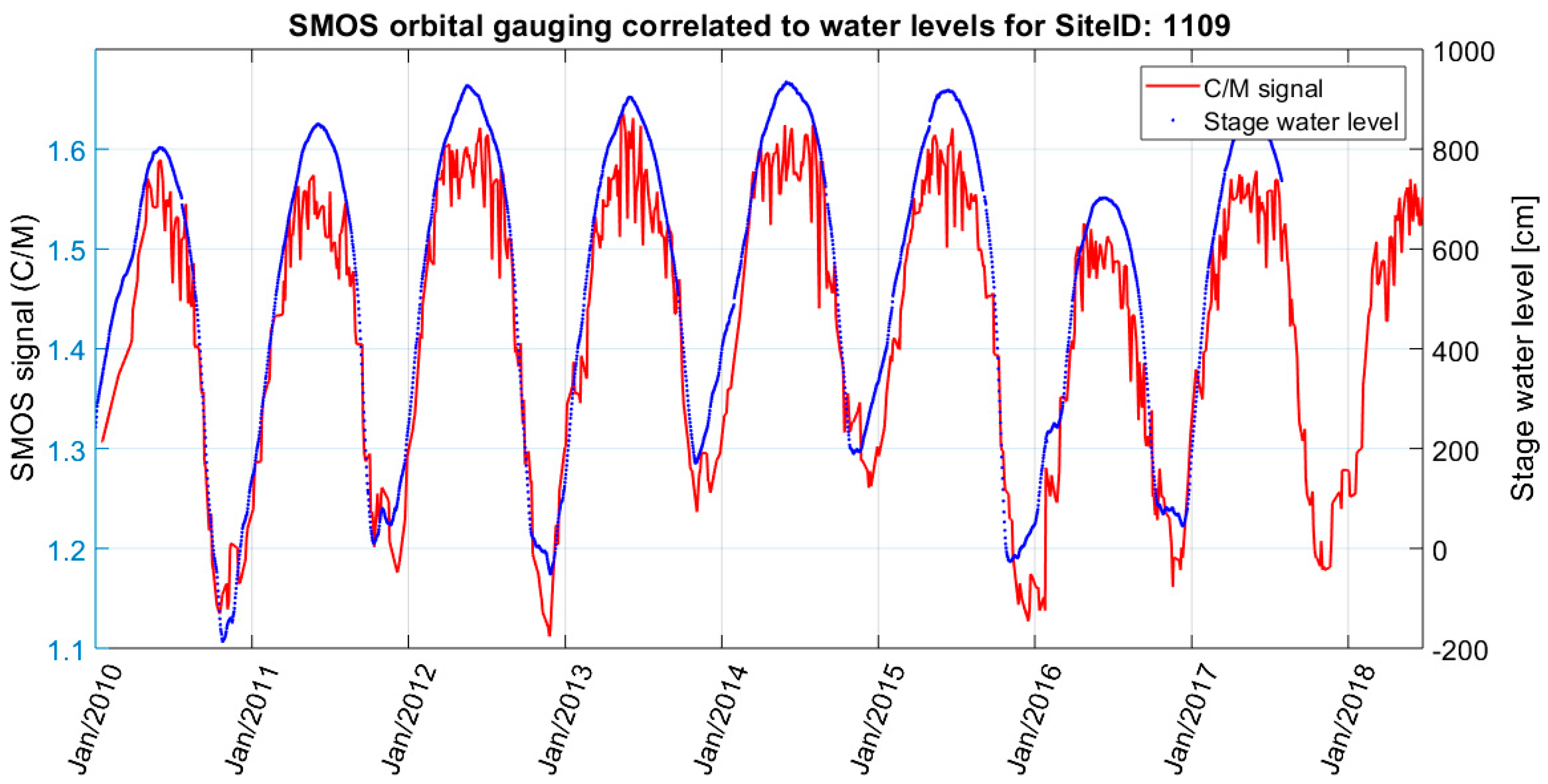
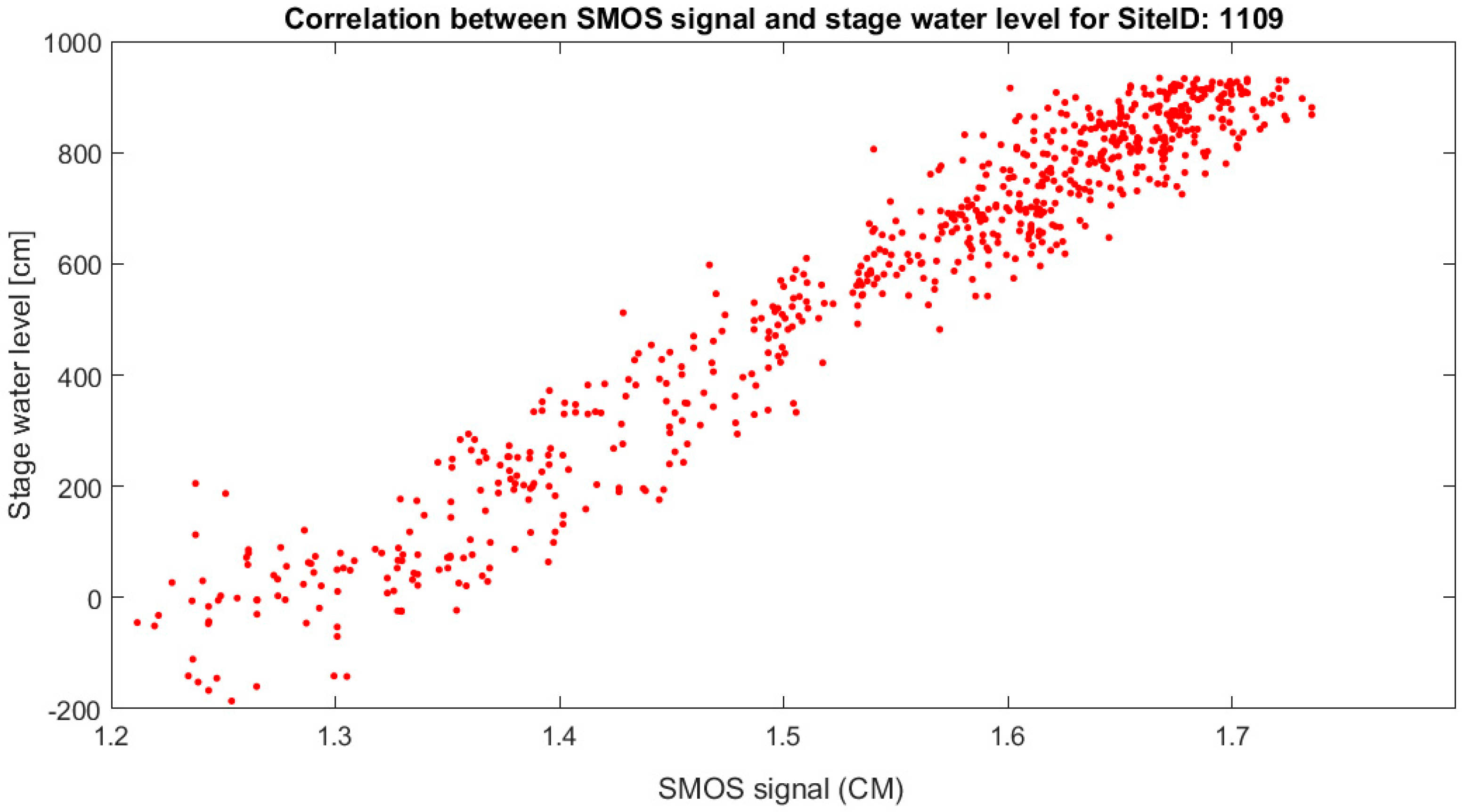
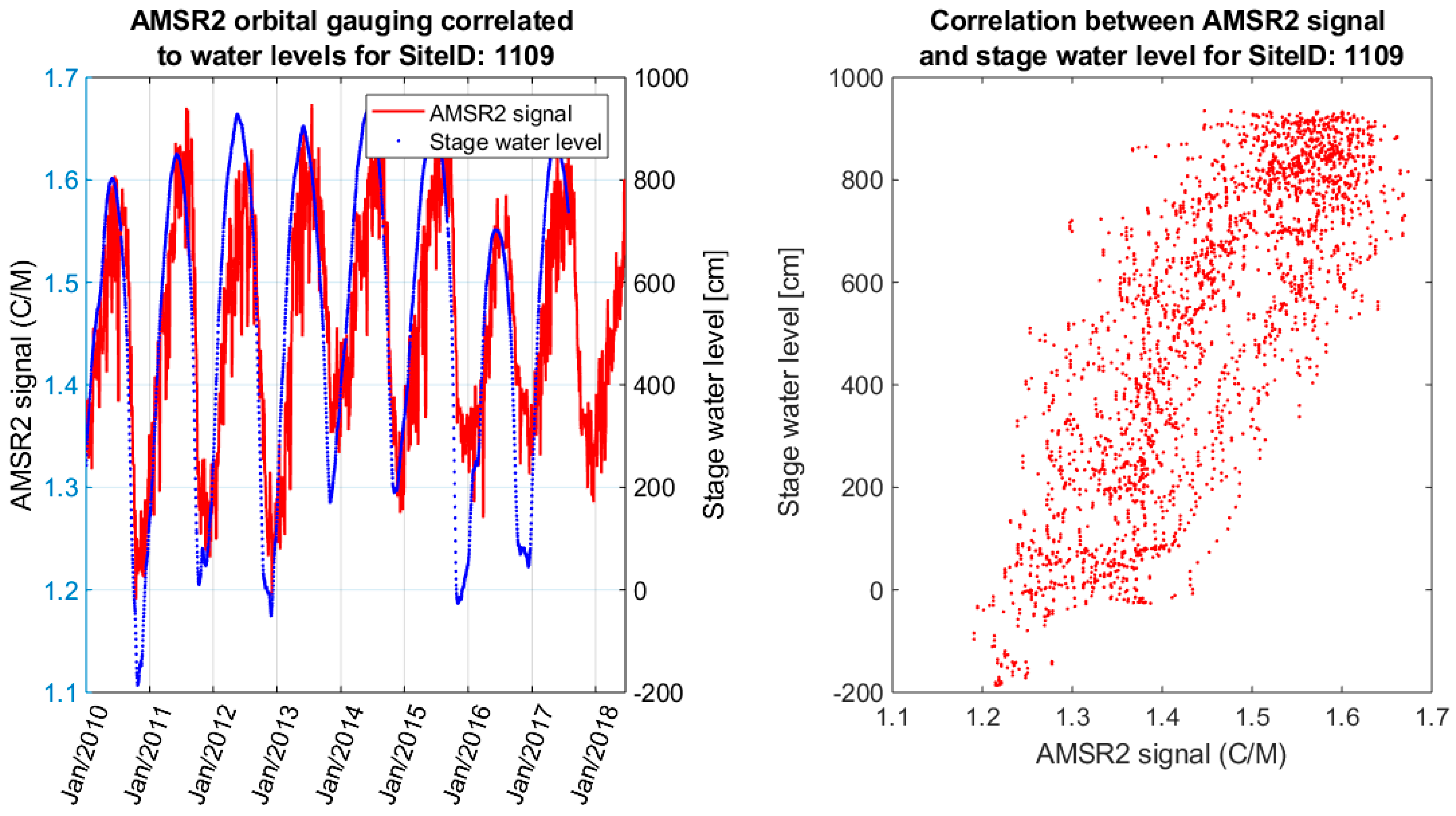
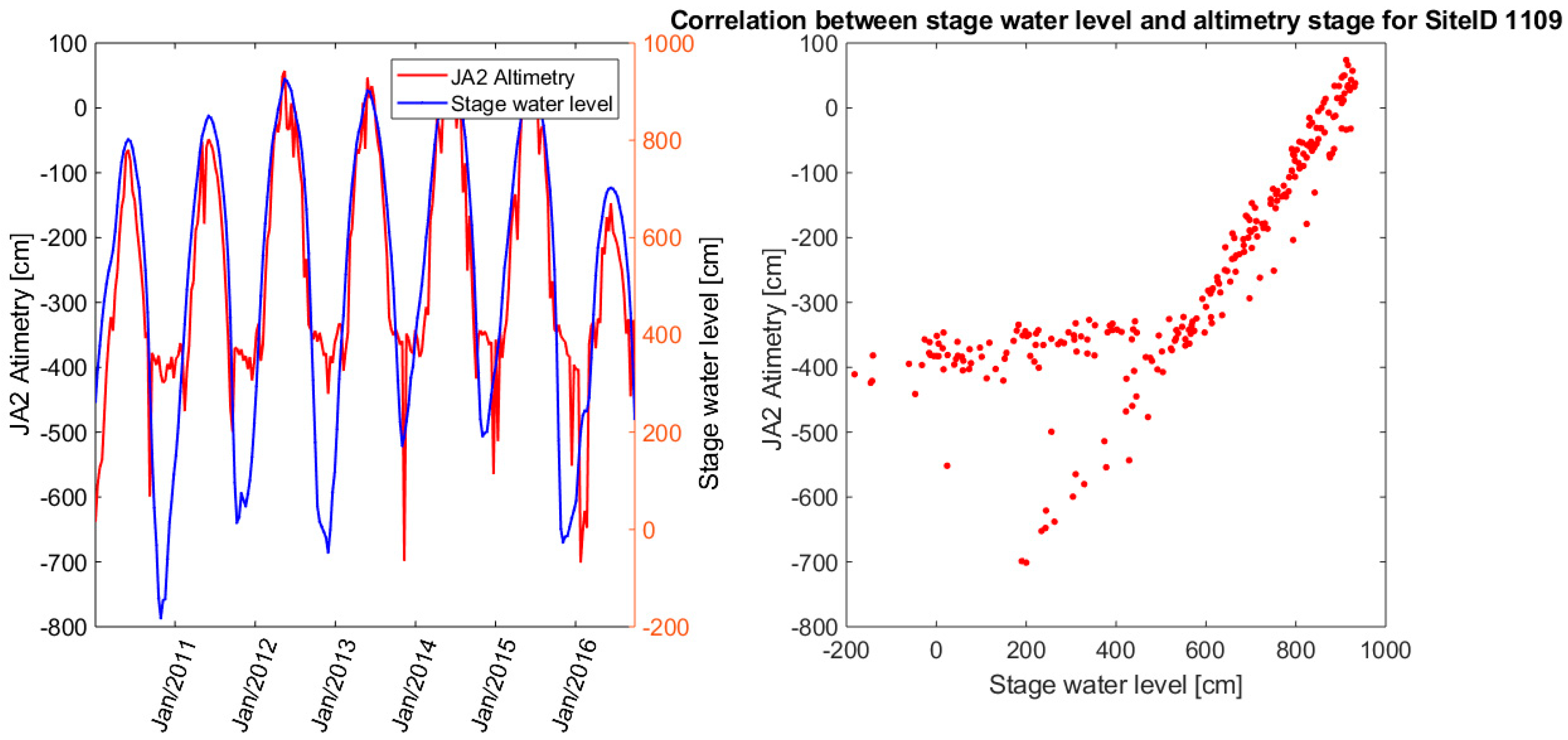
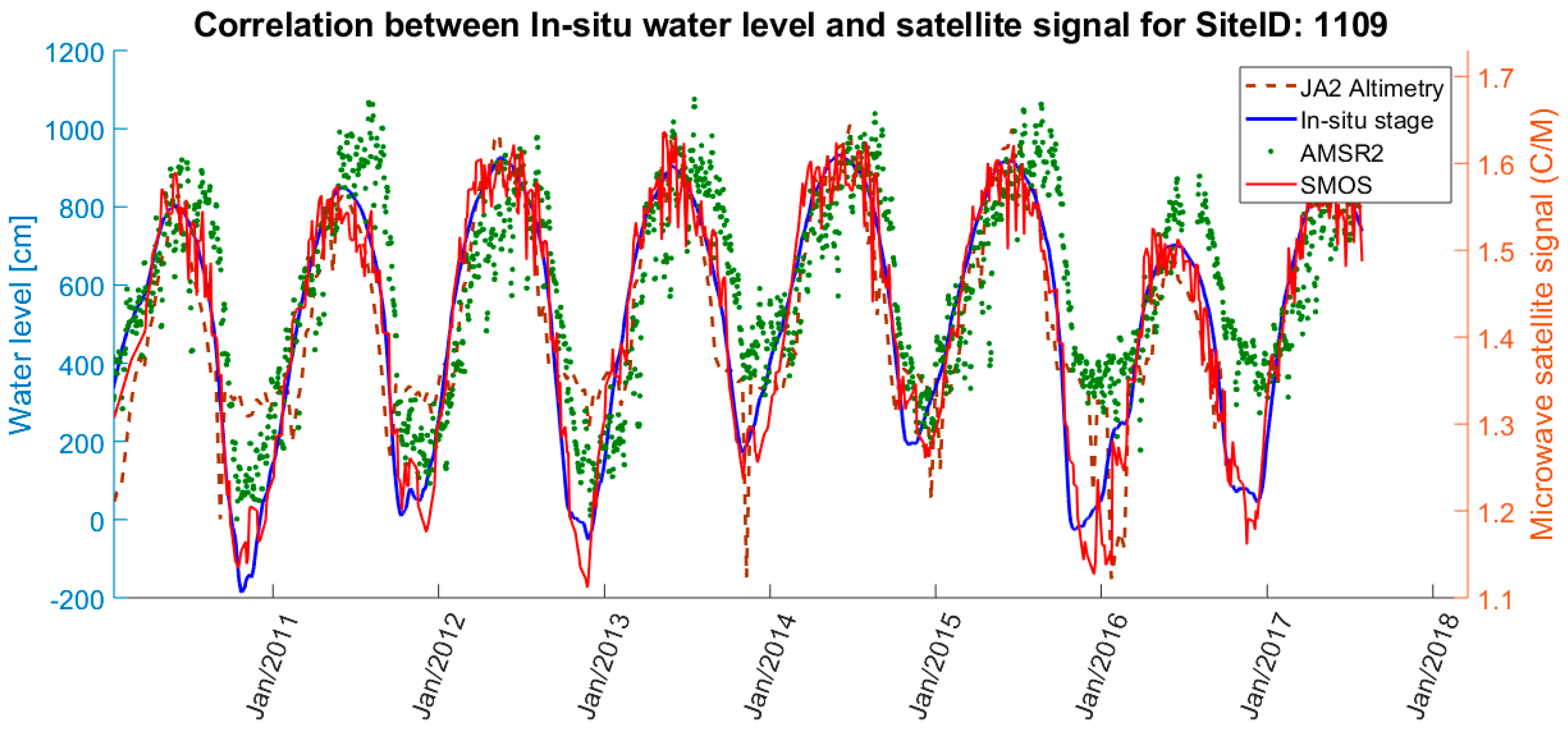
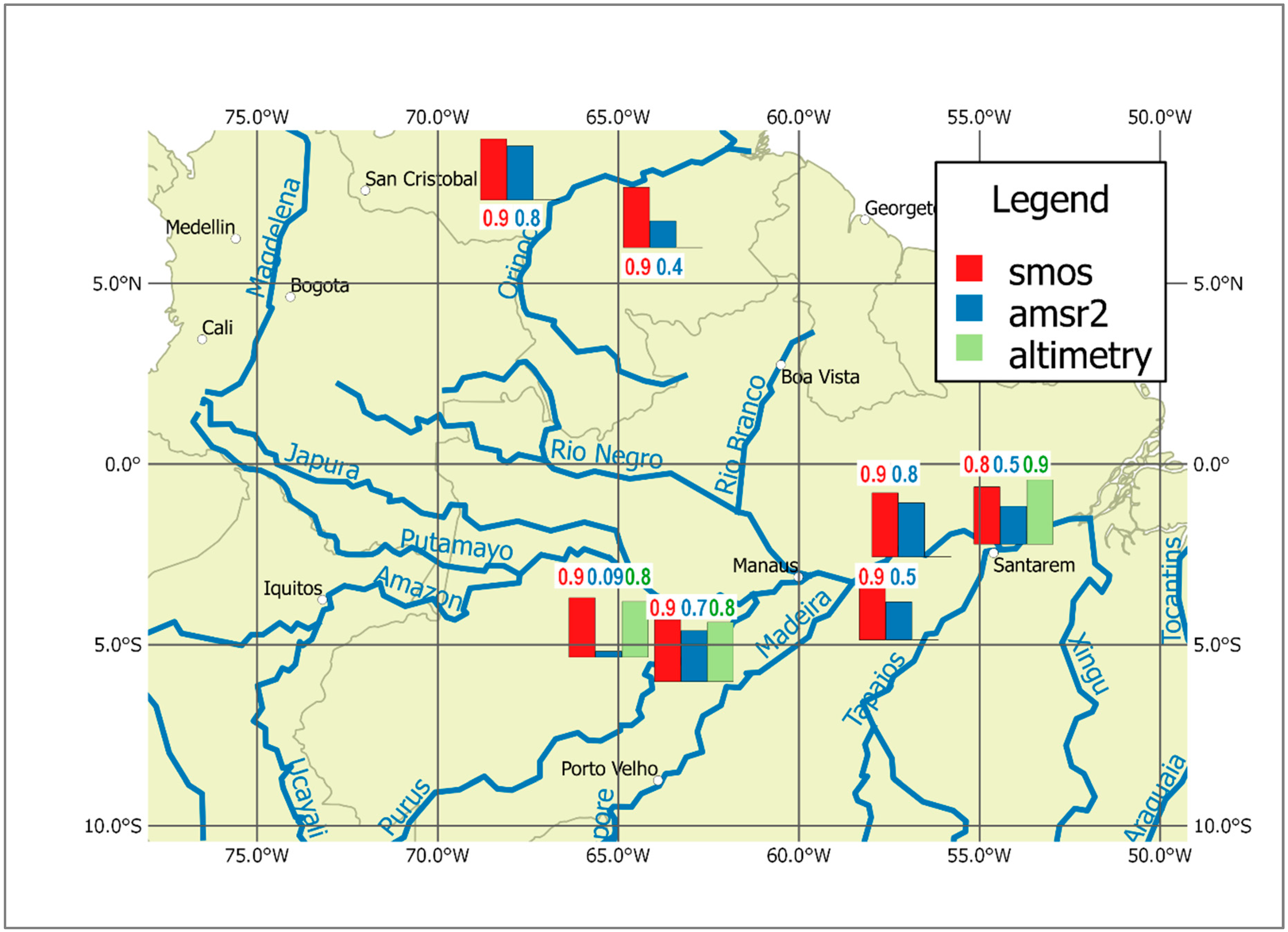
| Source | Sensor | Measurement | Temporal Coverage |
|---|---|---|---|
| CATDS | SMOS | water extent | 2010/01–2018/12 |
| GFDS | TRMM | water extent | 2011/09–2013/03 |
| AMSR-E | 2010/01–2011/09 | ||
| AMSR2 | 2013/04–2018/12 | ||
| SO Hybam | River Stage | water level | 2010/01–2018/12 inconstant for different stations |
| SO Hybam Altimetry | Jason 2, Jason 3 | water level | 2010/01–2018/12 inconstant for different stations |
| SMOS | AMSR2 | Altimetry | ||||
|---|---|---|---|---|---|---|
| River basin | ave. | std. | ave. | std. | ave. | std. |
| Amazon | 0.92 | 0.04 | 0.69 | 0.12 | 0.91 | 0.07 |
| Orinoco | 0.92 | 0.01 | 0.61 | 0.29 | ||
| Congo | 0.80 | 0.01 | 0.36 | 0.08 | ||
| SMOS | AMSR2 | Altimetry | ||||
|---|---|---|---|---|---|---|
| River basin | ave. | std. | ave. | std. | ave. | std. |
| Amazon | 0.84 | 0.08 | −1.48 | 1.28 | 0.77 | 0.14 |
| Orinoco | 0.83 | 0.01 | −2.23 | 0.59 | ||
| Congo | 0.38 | 0.33 | −1.79 | 0.05 | ||
© 2019 by the authors. Licensee MDPI, Basel, Switzerland. This article is an open access article distributed under the terms and conditions of the Creative Commons Attribution (CC BY) license (http://creativecommons.org/licenses/by/4.0/).
Share and Cite
Kugler, Z.; Nghiem, S.V.; Brakenridge, G.R. L-Band Passive Microwave Data from SMOS for River Gauging Observations in Tropical Climates. Remote Sens. 2019, 11, 835. https://doi.org/10.3390/rs11070835
Kugler Z, Nghiem SV, Brakenridge GR. L-Band Passive Microwave Data from SMOS for River Gauging Observations in Tropical Climates. Remote Sensing. 2019; 11(7):835. https://doi.org/10.3390/rs11070835
Chicago/Turabian StyleKugler, Zsofia, Son V. Nghiem, and G. Robert Brakenridge. 2019. "L-Band Passive Microwave Data from SMOS for River Gauging Observations in Tropical Climates" Remote Sensing 11, no. 7: 835. https://doi.org/10.3390/rs11070835
APA StyleKugler, Z., Nghiem, S. V., & Brakenridge, G. R. (2019). L-Band Passive Microwave Data from SMOS for River Gauging Observations in Tropical Climates. Remote Sensing, 11(7), 835. https://doi.org/10.3390/rs11070835






